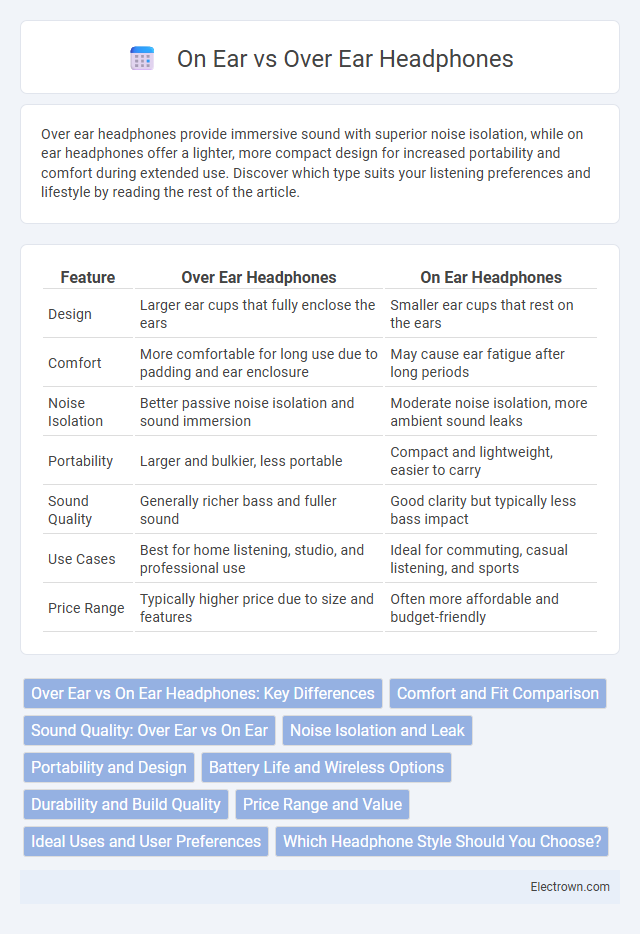Over ear headphones provide immersive sound with superior noise isolation, while on ear headphones offer a lighter, more compact design for increased portability and comfort during extended use. Discover which type suits your listening preferences and lifestyle by reading the rest of the article.
Table of Comparison
| Feature | Over Ear Headphones | On Ear Headphones |
|---|---|---|
| Design | Larger ear cups that fully enclose the ears | Smaller ear cups that rest on the ears |
| Comfort | More comfortable for long use due to padding and ear enclosure | May cause ear fatigue after long periods |
| Noise Isolation | Better passive noise isolation and sound immersion | Moderate noise isolation, more ambient sound leaks |
| Portability | Larger and bulkier, less portable | Compact and lightweight, easier to carry |
| Sound Quality | Generally richer bass and fuller sound | Good clarity but typically less bass impact |
| Use Cases | Best for home listening, studio, and professional use | Ideal for commuting, casual listening, and sports |
| Price Range | Typically higher price due to size and features | Often more affordable and budget-friendly |
Over Ear vs On Ear Headphones: Key Differences
Over ear headphones feature large ear cups that fully enclose the ears, offering superior noise isolation and enhanced bass response compared to on ear headphones, which rest directly on the ears with smaller pads. On ear headphones tend to be more lightweight and portable, making them ideal for casual listening and outdoor use, while over ear models provide greater comfort for extended wear due to better cushioning and ear coverage. Sound quality, comfort, and noise isolation are the primary factors distinguishing over ear from on ear headphones, influencing user preference based on usage scenarios.
Comfort and Fit Comparison
Over ear headphones provide superior comfort for long listening sessions due to their large ear cups that fully enclose your ears, reducing pressure and heat build-up. On ear headphones offer a more compact design and lighter weight, which can be preferable for portability but may cause discomfort or pressure with extended use. Your choice depends on prioritizing either long-term comfort with over ear models or convenience and portability with on ear headphones.
Sound Quality: Over Ear vs On Ear
Over ear headphones typically deliver superior sound quality with enhanced bass response and wider soundstage due to their larger ear cups that fully enclose the ears, reducing external noise interference. On ear headphones provide a more compact design but often compromise on audio depth and bass clarity because they sit directly on the ears without full sealing. Your choice between the two will affect immersion and audio detail, especially in environments where noise isolation is crucial.
Noise Isolation and Leak
Over ear headphones provide superior noise isolation by fully enclosing the ears, effectively blocking external sounds and minimizing sound leakage. On ear headphones rest directly on the ears, offering moderate noise isolation but allowing more ambient noise to penetrate and higher sound leakage. Choosing over ear models enhances sound immersion and privacy by reducing both incoming noise and outgoing audio escape.
Portability and Design
Over ear headphones feature large ear cups that fully enclose the ears, providing superior noise isolation but resulting in bulkier designs that are less portable for daily commuting. On ear headphones have smaller ear pads that rest directly on the ears, offering a lightweight and compact form factor ideal for portable use and easy storage. The design differences impact comfort and convenience, with on ear models favoring portability and over ear headphones prioritizing immersive sound experience.
Battery Life and Wireless Options
Over ear headphones typically offer longer battery life, often exceeding 20 hours on a single charge, making them ideal for extended wireless use. On ear headphones generally provide shorter battery duration, averaging around 10 to 15 hours, but are often more compact and lightweight. Both styles support wireless connectivity via Bluetooth, with over ear models frequently featuring advanced codecs for improved audio quality and range.
Durability and Build Quality
Over ear headphones typically offer superior durability due to larger, more robust ear cups and reinforced headbands that withstand frequent use and rough handling. On ear headphones often feature compact, lightweight designs which may sacrifice build quality for portability, making them more susceptible to wear and tear over time. Materials such as aluminum frames and memory foam padding in over ear models contribute to longer lifespan and sustained comfort.
Price Range and Value
Over ear headphones typically offer a broader price range from budget-friendly models around $50 to premium options exceeding $300, delivering superior sound quality and noise isolation that justify the investment. On ear headphones usually cost between $30 and $150, providing a balance of portability and decent audio performance at a lower price point. Your choice should reflect whether you prioritize immersive sound and comfort or affordability and convenience.
Ideal Uses and User Preferences
Over ear headphones provide superior noise isolation and are ideal for immersive listening experiences, such as gaming, studio mixing, or long music sessions. On ear headphones are preferred for portability and casual use, offering a lightweight design suited for commuting or office environments where external sound awareness is beneficial. User preferences often depend on comfort, sound isolation needs, and situational awareness requirements during use.
Which Headphone Style Should You Choose?
Over ear headphones provide superior sound quality, enhanced noise isolation, and greater comfort for extended use, making them ideal for audiophiles and long listening sessions. On ear headphones offer a lighter, more compact design with better portability and breathability, suitable for casual users and daily commuting. Choosing between the two depends on your priorities for sound immersion, comfort, and convenience in various environments.
Over Ear vs On Ear Headphones Infographic

 electrown.com
electrown.com